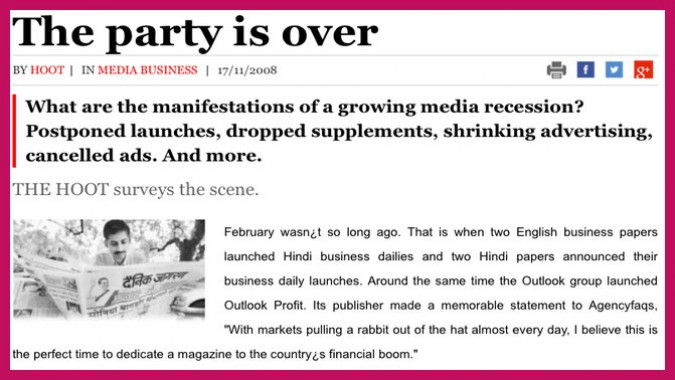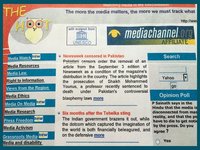“Bad news folks, and warm regards”— the media recession of 2008
By November 2008 we were reporting that the party was over.
In February 2008 two English business papers launched Hindi business dailies and two Hindi papers announced their business daily launches. Around the same time the Outlook group launched Outlook Profit. Its publisher told Agencyfaqs, that “with markets pulling a rabbit out of the hat almost every day, the it seemed perfect time to dedicate a magazine to the country’s financial boom."
By November the same publisher was sending out a circular to the Outlook stable staff suggesting belt tightening for hard times ahead, and redeployment of excess staff in each team. And the magazine dropped two supplements which used to be distributed free with it. India Today dropped three supplements they used to distribute free with the main magazine, and two supplements which it used to distribute with its Bengali edition.
In February Dainik Jagran’s business daily venture with CNBC TV18 was on the cards. By November it no longer was, and the CEO hired for the project has departed. Business Standard’s Gujarati paper launched in February 2008 from Ahmedabad and Mumbai with an ad line which said that over 35 per cent of stock market wealth was held by Gujaratis. Then both editions shut shop. Majaor English newspapers began to cut pages. The Times of India has squeezed sections into the main paper. Publications across the board were displaying weight loss. The launch of Forbes which was supposed to come from the TV18 stable was postponed. (It finally surfaced in May 2009).
Advertising and profits crashed
Because advertising had begun to crash. Three new general entertainment TV channels that had entered the market over the preceding year 9X, NDTV Imagine, and Colours, were being told by a research agency that their short-term prospects would remain difficult.
Broadcasters had begun to contemplate reducing the carriage fees paid to cable operators for better placement of channels.
Company results for the second quarter of 2008-2009 for listed media companies s howed NDTV reported a net loss of Rs 119 crore, HT Media’s profits were down by 49 per cent, only Sun TV Network, the highest valued TV company with a market cap of Rs 6234 crore reported a modest rise in profits.
At the same time it was losing market cap fast-- Sun TV Network was down to 162 in November from a 52 week high of 442.
Both TV news and entertainment companies as well as print media companies were losing value sharply on the stock market.
With the collapse of advertising following the economic slowdown advertisements became progressively intrusive and advertisers were able to dictate terms more favourable to themselves. Through 2009 newspapers which had remained conservative about the ad positioning they would allow, began to give in. Some of them, like the Hindu and Business Standard, began to sport far more half jacket ads, which enclosed the entire front page, than before.
Media outlets grew desperate enough for advertising to allow any positioning demanded. But even so the SundayHindustan Times took the cake in October 2009: it had a front page bathed in an ad for a bathing bar. You could read the headlines through the bubbles. Then they repeated the page inside without the soapy effect. (Fiama Di headlines)
Increment cuts, salary cuts
By March 2009 TOI and NDTV were writing to staffers spelling out salary cuts that would be enforced. (Bad news folks, and warm regards) Ravi Dhariwal, then CEO of The Times of India Group, wrote to employees.
“Instead of growing like in the previous three months, we saw advertising decline by almost a quarter, and, because over 90% of our revenue comes from advertising revenue, this has been huge barrier for us.” He went on to suggest “personal adjustments and sacrifices for a greater cause”. The sacrifices proposed were no salary revision in August, no TVP payout, and even a graded roll back of increment for all employees : those “who got a smaller increase will get a lower reduction and the employees who got a higher increase will have a higher reduction of their increment.”
The same month NDTV CEO KVL Narayan Rao wrote to employees to say that
India and the world were in the midst of an economic crisis, NDTV, like all other media companies has also been affected by lower advertising revenues, that the company’s results were showing an operating loss, and in the interim salary cuts would have to be implemented. These would be for all who earn over one lakh rupees a month, would those paid more taking a greater percentage cut.
At the same time the company known for its generosity to employees stressed that there would be no cutbacks on many of the community facilities, such as the crèche, NDTV’s doctor or medical schemes, drop backs for women after dark and “many of the other facilities that are so important for NDTV.”
On a tragic note, IANS reported on November 6 2008 that a 32-year-old journalist, fired from his job by a Hindi magazine a few days ago, committed suicide at his home in Delhi. "The police said they found no suicide note but quoted the distraught family as saying that Chanderkant was under stress since being sacked. The dead journalist is survived by his wife and two children."
International pointers
The Hoot also captured two interesting international repercussions of the 2008 recession. Because online advertising has suffered almost as much as its print and broadcast siblings from the global economic implosion Google strategized to fight back by making its user tracking more intrusive so that it could serve up more sharply targeted ads.
And in an unusual repercussion, the Organization of News Ombudsmen, was reporting that the recession hitting the media sector has seen 12 ombudsmen lose their jobs. Its president said, " The first people who seem to go are reader’s editors. We are not the most popular people in the world."
Finally, we should add that by the end of the year 2010 there were definite signs of recovery. The Times of India grew so fat with advertising that hawkers issued a statement in protest against the ‘load factor’, and slipped it into the papers they were delivering. They said they were compelled to reduce the weight of the paper by dropping the Bombay Times!
Visit The Hoot Archive, now part of Ashoka Archives, at www.thehoot.org








